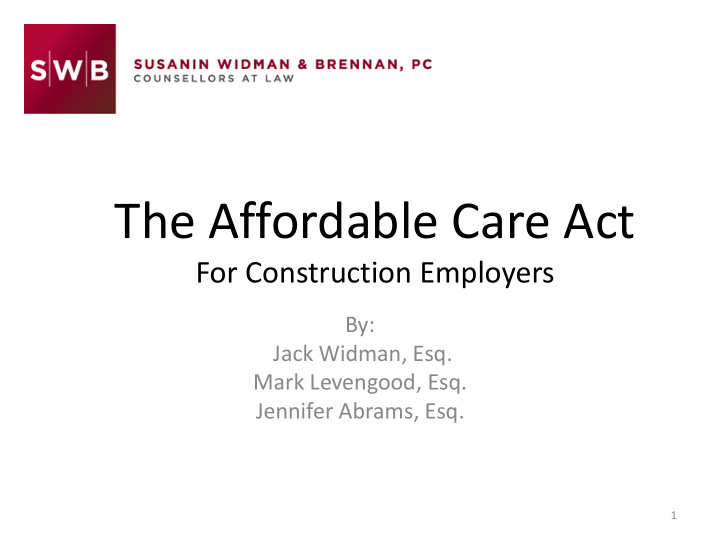



The Affordable Care Act For Construction Employers By: Jack Widman, Esq. Mark Levengood, Esq. Jennifer Abrams, Esq. 1
Overview • Employer Mandate • Shared Responsibility Information Return • W-2 Reporting • FLSA Notices 2
Enforcement Transition Relief • 2014 – Suspended • 2015 – Suspended for Applicable Large Employers with 99 or fewer full-time employees on average • 2016 – Fully effective 3
Employer Mandate Generally • Applicable Large Employers • Must offer Affordable and Minimum Value coverage • To Full-Time Employees and their dependents • Or face Penalties – Penalties are triggered by tax credits in the exchanges 4
Who is a Large Employer? • Prior calendar year average – 2015: 99 or more full-time employees (including full- time equivalents) – 2016: 50 or more – 2 groups to track • Employees averaging 30 hours weekly in a month • All other employees’ hours divided by 120 – Full Time Equivalents – Track all hours • Exempt and non-exempt • CBA and non-CBA 5
How do you calculate Large Employer Status? • 12 monthly snapshots • 2015 Relief - 6 monthly snapshots from 2014 – Consecutive • Controlled Group rules apply • Seasonal worker exception (4 months) 6
What is Affordable, Minimum Value coverage? • To avoid penalties, the coverage offered to full- time employees must be affordable and minimum value – Affordable • 9.5% of household income (safe harbors: W-2, rate of pay) • Self-only coverage – Minimum Value • 60% of projected costs for a standardized population (self- insured GHP) 7
Who is a “full - time” employee? • CBA versus non-CBA – Multiemployer Safe Harbor (discussed later) • 30 hours on average weekly in a month – Current tax year • New full-time employees – Enroll by first day of fourth full calendar month following start date • No penalties prior to that date 8
Dependents of full-time employees? • Offer of coverage required – No minimum level of coverage • Transition relief for the 2015 plan year – an employer will not be penalized for failing to offer coverage to dependents of full-time employees • Provided employer is “taking steps” in 2014 and 2015 9
Multiemployer Safe Harbor • Safe Harbor Components – Large Employer – CBA or Participation Agreement (bargaining unit alumni, office staff) – Contributions required – Plan offers affordable, minimum value coverage – Plan offers coverage subject to plan’s eligibility conditions • FT status in current month does not trigger a penalt y • Delinquency? – No guidance 10
De Minimis Transition Relief • Relief from “No Coverage” penalty – Allows for a margin of error • 2015 only – No penalties if ALE: • offers coverage to 70% of full-time employees • 2016 and going forward – 70% increased to 95% 11
Part-time or variable hour employees? • Fluctuating hours – Reacting to monthly averages is impractical • “Look back” method is optional way to deal with problem of variable hour/seasonal employee 12
Look back Method – Ongoing EEs • “standard measurement period” – 3 to 12 months • “stability period” – 6 to 12 months (equal to measurement period) • “administrative period” – Optional – up to 90 days, between end of standard measurement period and stability period 13
Employer Mandate Penalties • The “No Coverage” Penalty – Opt out vs. mistake – Penalty based on entire full-time population – Originally triggered by a failure to offer to one full- time employee – Month by month – 1/12 of $2,000 – Modified by regulations 14
Employer Mandate Penalties • The “Bad Coverage” Penalty – Failure to offer MV/affordable coverage – Penalty limited to affected employee – Month by month – 1/12 of $3,000 15
Assessment of Penalties • IRS notice of assessment – Post-calendar year • Opportunity to defend – Facts and circumstances – Large Employer status – De Minimis Relief – Safe Harbors 16
Timeline Cheat Sheet • Separate handout • Year by year steps to follow leading up to 2016 17
Shared Responsibility Information Return • Applies only to ALEs • Annual filing to IRS, Annual Statement to Employees • Content includes: – Name, EIN – Certification that coverage offered to full-time employees and their dependents (by calendar month) – Months coverage was available – Lowest cost monthly self-only premium – Employer’s number of full -time employees for each month during the calendar year – The name, address, and TIN of each full-time employee – Months each full-time employee was covered 18
Shared Responsibility Information Return, cont. • Multiemployer Plan permitted to report information for ALE with respect to participating employees • Non-CBA employees? • Certification for 2015 Transition Relief 19
W-2 REPORTING • Optional for employers contributing to multiemployer plans • Non CBA employees – only for employers required to file 250 or more W-2s in the year 20
FLSA NOTICES • Every employer (not only Large Employers) – Not a plan requirement • Every employee (eligible or ineligible) • Content – describe exchanges/marketplaces – employer-provided coverage – Minimum Value – yes or no? – tax consequences of choosing exchange coverage over employer coverage (pre-tax v. post-tax) • Timing – existing employees: 10/1/13 – new employees: within 14 days of hire 21
FLSA Notices • No Penalties • Multiemployer Relief – Issue • MEPs calculate minimum value, not employers – Plans may assume employers’ obligation • Relief only helpful for ongoing participants as of 10/1/13 – Plans likely incapable of timely notifying new employees within 14 days • Lag in contribution reporting to plans – typically a 45 day process • Non CBA Employees 22
QUESTIONS? 23
Contact Susanin, Widman & Brennan, P.C. 1285 Drummers Lane, Suite 202 Wayne, PA 19087 (610) 710-4510 www.swbcounsellors.com Jack Widman, Esq., jwidman@swbcounsellors.com Mark Levengood, Esq., mlevengood@swbcounsellors.com Jennifer Abrams, Esq., jabrams@swbcounsellors.com 24
Recommend
More recommend